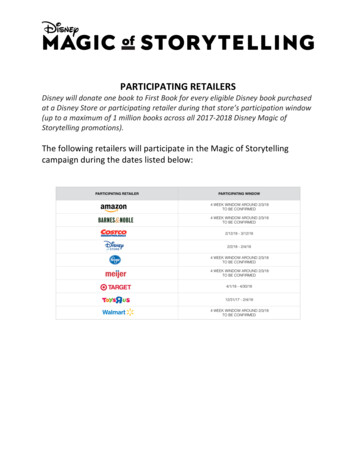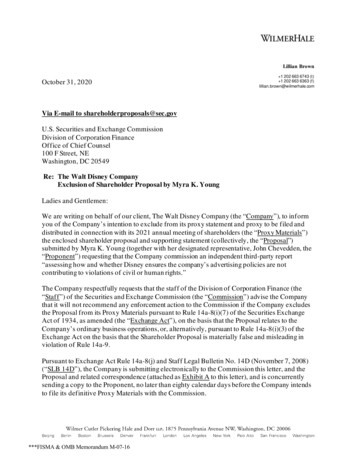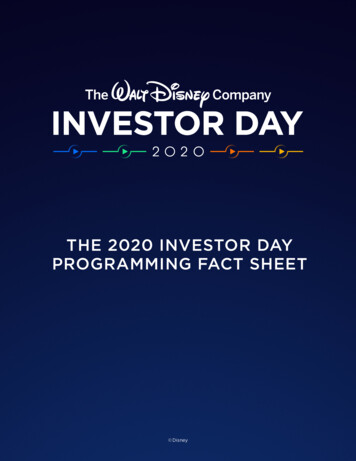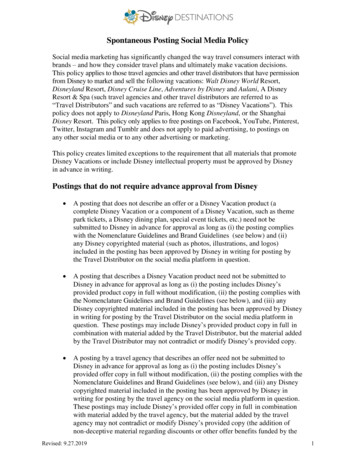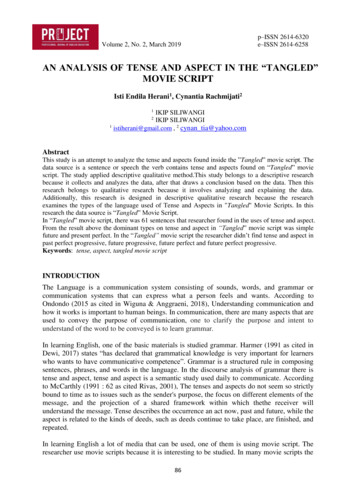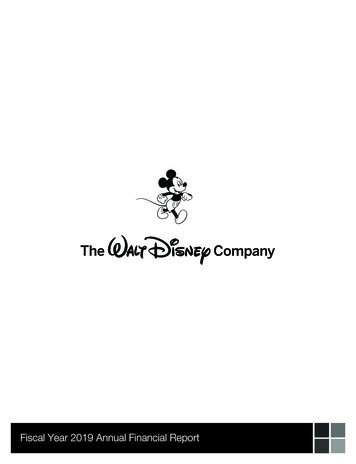
Transcription
6JAN201605190975Fiscal Year 2019 Annual Financial Report13DEC201905470521
UNITED STATESSECURITIES AND EXCHANGE COMMISSIONWashington, D.C. 20549FORM 10-KANNUAL REPORT PURSUANT TO SECTION 13 OR 15(d) OF THE SECURITIES EXCHANGE ACT OF 1934For the fiscal year ended September 28, 2019orTRANSITION REPORT PURSUANT TO SECTION 13 OR 15(d) OF THE SECURITIES EXCHANGE ACT OF 1934For the transition period from to .Commission File Number 001-38842DelawareState or Other Jurisdiction ofIncorporation or Organization83-0940635I.R.S. Employer Identification500 South Buena Vista StreetBurbank, California 91521Address of Principal Executive Offices and Zip Code(818) 560-1000Registrant’s Telephone Number, Including Area CodeSecurities registered pursuant to Section 12(b) of the Act:Title of each classCommon Stock, 0.01 par valueTrading Symbol(s)DISName of each exchange on which registeredNew York Stock ExchangeSecurities Registered Pursuant to Section 12(g) of the Act: None.Indicate by check mark if the registrant is a well-known seasoned issuer, as defined in Rule 405 of the Securities Act. YesIndicate by check mark if the registrant is not required to file reports pursuant to Section 13 or Section 15(d) of the Act. YesNoNoIndicate by check mark whether the registrant (1) has filed all reports required to be filed by Section 13 or 15(d) of the Securities Exchange Actof 1934 during the preceding 12 months (or for such shorter period that the registrant was required to file such reports), and (2) has been subject to suchfiling requirements for the past 90 days. YesNoIndicate by check mark whether the registrant has submitted electronically every Interactive Data File required to be submitted pursuant to RuleNo405 of Regulation S-T during the preceding 12 months (or for such shorter period that the registrant was required to submit such files). YesIndicate by check mark whether the registrant is a large accelerated filer, an accelerated filer, a non-accelerated filer, a smaller reporting companyor an emerging growth company. See the definitions of “large accelerated filer”, “accelerated filer”, “smaller reporting company”, and “emerginggrowth company” in Rule 12b-2 of the Exchange Act.Large accelerated filerAccelerated filerNon-accelerated filerSmaller reporting companyEmerging growth companyIf an emerging growth company, indicate by check mark if the registrant has elected not to use the extended transition period for complying withany new or revised financial accounting standards provided pursuant to Section 13(a) of the Exchange Act.Indicate by check mark whether the registrant is a shell company (as defined in Rule 12b-2 of the Act). YesNoThe aggregate market value of common stock held by non-affiliates (based on the closing price on the last business day of the registrant’s mostrecently completed second fiscal quarter as reported on the New York Stock Exchange-Composite Transactions) was 199.5 billion. All executiveofficers and directors of the registrant and all persons filing a Schedule 13D with the Securities and Exchange Commission in respect to registrant’scommon stock have been deemed, solely for the purpose of the foregoing calculation, to be “affiliates” of the registrant.There were 1,802,398,289 shares of common stock outstanding as of November 13, 2019.Documents Incorporated by ReferenceCertain information required for Part III of this report is incorporated herein by reference to the proxy statement for the 2020 annual meeting ofthe Company’s shareholders.
THE WALT DISNEY COMPANY AND SUBSIDIARIESTABLE OF CONTENTSPagePART IITEM 1.Business1ITEM 1A.Risk Factors18ITEM 1B.Unresolved Staff Comments25ITEM 2.Properties25ITEM 3.Legal Proceedings26ITEM 4.Mine Safety Disclosures26Executive Officers of the Company26PART IIITEM 5.Market for the Company’s Common Equity, Related Stockholder Matters and Issuer Purchases of EquitySecurities27ITEM 6.Selected Financial Data28ITEM 7.Management’s Discussion and Analysis of Financial Condition and Results of Operations29ITEM 7A.Quantitative and Qualitative Disclosures About Market Risk60ITEM 8.Financial Statements and Supplementary Data61ITEM 9.Changes in and Disagreements with Accountants on Accounting and Financial Disclosure61ITEM 9A.Controls and Procedures61ITEM 9B.Other Information62PART IIIITEM 10.Directors, Executive Officers and Corporate Governance63ITEM 11.Executive Compensation63ITEM 12.Security Ownership of Certain Beneficial Owners and Management and Related Stockholder Matters63ITEM 13.Certain Relationships and Related Transactions, and Director Independence63ITEM 14.Principal Accounting Fees and Services63PART IVITEM 15.Exhibits and Financial Statement Schedules64ITEM 16.Form 10-K Summary67SIGNATURES68Consolidated Financial Information — The Walt Disney Company69
PART IITEM 1. BusinessThe Walt Disney Company, together with its subsidiaries, is a diversified worldwide entertainment company withoperations in four business segments: Media Networks; Parks, Experiences and Products; Studio Entertainment; and Direct-toConsumer & International (DTCI).For convenience, the terms “Company”, “we” and “our” are used to refer collectively to the parent company and thesubsidiaries through which businesses are conducted.The Company employed approximately 223,000 people as of September 28, 2019.On March 20, 2019, the Company acquired the outstanding capital stock of Twenty-First Century Fox, Inc., which wassubsequently renamed TFCF Corporation, a diversified global media and entertainment company. Prior to the acquisition,TFCF and a newly-formed subsidiary of TFCF (New Fox) entered into a separation agreement, pursuant to which TFCFtransferred to New Fox a portfolio of TFCF’s news, sports and broadcast businesses and certain other assets. TFCF retained allof the assets and liabilities not transferred to New Fox, the most significant of which were the Twentieth Century Fox film andtelevision studios, certain cable networks (primarily FX and National Geographic), TFCF’s international television businesses(including Star) and TFCF’s 30% interest in Hulu LLC (Hulu). Under the terms of the agreement governing the acquisition, theCompany will generally phase-out Fox brands by 2024, but has perpetual rights to certain Fox brands, including the TwentiethCentury Fox and Fox Searchlight brands.As a result of the acquisition, the Company’s ownership interest in Hulu increased to 60%, and the Company startedconsolidating the results of Hulu as of the acquisition date. In May 2019, the Company increased its ownership interest in Huluto 67%, with NBC Universal (NBCU) owning the remaining 33%. Also in May 2019, the Company entered into a put/callagreement with NBCU that provided the Company with full operational control of Hulu. In order to obtain regulatory approvalfor the acquisition of TFCF, the Company agreed to sell TFCF’s regional sports networks (RSN) and sports media operations inBrazil and Mexico. The sale of the RSNs was completed in August 2019.See Notes 4, 12 and 19 of the Consolidated Financial Statements for additional information on the TFCF, Hulu and RSNstransactions.In November 2019, the Company launched Disney , a subscription based direct-to-consumer video streaming servicewith Disney, Pixar, Marvel, Star Wars and National Geographic branded programming. The service was launched in the U.S.and four other countries, with further launches in other countries planned throughout 2020 and 2021.MEDIA NETWORKSSignificant operations: Disney, ESPN, Freeform, FX and National Geographic branded domestic cable networks ABC branded broadcast television network and eight owned domestic television stations Television production and distribution National Geographic magazines A 50% equity investment in A E Television Networks (A E)Significant revenues: Affiliate fees - Fees charged to multi-channel video programming distributors (i.e. cable, satellite, telecommunicationsand digital over-the-top (OTT) (e.g. Hulu, YouTube TV) service providers (MVPDs) and to television stationsaffiliated with the ABC Network for the right to deliver our programming to their customers Advertising - Sales of advertising time/space on our domestic networks and related platforms (“ratings-based adsales”, which excludes advertising on digital platforms that is not ratings-based), and the sale of advertising time onour domestic television stations. Ratings-based ad sales are generally determined using viewership measured withNielsen ratings. Non-ratings-based advertising on digital platforms is reported by DTCI. TV/SVOD distribution - Licensing fees and other revenues from the right to use our television programs andproductions and revenue from content transactions with other Company segments (“program sales”)Significant expenses: Operating expenses consisting primarily of programming and production costs, participations and residuals expense,technical support costs, operating labor and distribution costs Selling, general and administrative costs Depreciation and amortization1
Domestic Cable NetworksOur domestic cable networks produce their own programs and also acquire programming rights from our television andtheatrical production operations and third parties. The majority of the domestic cable networks’ revenue is derived fromaffiliate fees and advertising sales. Generally, the Company’s cable networks provide programming under multi-year licensingagreements with MVPDs that include contractually specified rates on a per subscriber basis. The amounts that we can charge toMVPDs for our cable network programming is largely dependent on the quality and quantity of programming that we canprovide and the competitive market for programming services. The ability to sell advertising time and the rates received areprimarily dependent on the size and nature of the audience that the network can deliver to the advertiser as well as overalladvertiser demand. We also sell programs developed by our cable networks worldwide to television broadcasters, tosubscription video-on-demand (SVOD) services (such as Netflix, Hulu and Amazon) and in home entertainment formats (suchas DVD, Blu-ray and electronic home video license). In fiscal 2020, we expect a significant portion of our programs to belicensed to DTCI.The Company’s significant domestic cable channels and the number of subscribers (in millions) as estimated by NielsenMedia Research as of September 2019 (1) (except where noted) are as follows:EstimatedSubscribersDisneyDisney ChannelDisney JuniorDisney XDESPN86ESPNESPN2ESPNUESPNEWSSEC Network (2)FreeformFX838361585985FXFXMFXXNational Geographic87568466688659National GeographicNational Geographic Wild(1)(2)Estimates include traditional MVPD and the majority of digital OTT subscriber counts.Because Nielsen Media Research does not measure this channel, estimated subscribers are according to SNL Kagan asof December 2018.DisneyBranded television channels include Disney Channel, Disney Junior and Disney XD. Programming for these channelsincludes internally developed and acquired programming. The Disney branded channels also provide programming for videoon-demand services and through the DisneyNOW App and website, both of which are operated by DTCI.Disney Channel - the domestic Disney Channel airs original series and movie programming 24 hours a day targeted tokids ages 2 to 14. Disney Channel develops and produces shows for exhibition on its channel, including live-action comedyseries, animated programming and preschool series, as well as original movies. Disney Channel also airs programming andcontent from Disney’s theatrical film and television programming library.Disney Junior - the domestic Disney Junior channel airs programming 24 hours a day targeted to kids ages 2 to 7 andtheir parents and caregivers. The channel features animated and live-action programming that blends Disney’s storytelling andcharacters with learning. Disney Junior also airs as a programming block on the Disney Channel.2
Disney XD - the domestic Disney XD channel airs programming 24 hours a day to kids ages 6 to 11. The channel featuresa mix of live-action and animated programming.ESPNESPN is a multimedia sports entertainment company owned 80% by the Company and 20% by Hearst Corporation(Hearst). ESPN operates nine 24-hour domestic television sports channels: ESPN and ESPN2 (both of which are sportschannels dedicated to professional and college sports as well as sports news and original programming), ESPNU (which isdevoted to college sports), ESPNEWS (which simulcasts weekday ESPN Radio programming, re-airs select ESPN studioshows and airs a variety of other programming), SEC Network (which is dedicated to Southeastern Conference collegeathletics), ESPN Classic (which airs rebroadcasts of famous sporting events, sports documentaries and sports-themed movies),Longhorn Network (which is dedicated to The University of Texas athletics), ESPN Deportes (which airs professional andcollege sports, as well as studio shows in Spanish), and ACC Network (which is dedicated to Atlantic Coast Conference collegeathletics). ESPN programs the sports schedule on the ABC Television Network, which is branded ESPN on ABC.ESPN holds rights for various professional and college sports programming including college football (including bowlgames and the College Football Playoff) and basketball, the National Basketball Association (NBA), the National FootballLeague (NFL), Major League Baseball (MLB), US Open Tennis, the Professional Golfers’ Association (PGA) Championship,various soccer rights, the Wimbledon Championships and the Masters golf tournament.ESPN provides programming for the following, which are operated by DTCI: ESPN.com - which delivers sports news, information and video on internet-connected devices, with approximately 20editions in three languages globally. In the U.S., ESPN.com also features live video streams of ESPN channels toauthenticated MVPD subscribers. Non-subscribers have limited access to certain content. ESPN App - which delivers scores, news, highlights, short form video, podcasts and live audio, with fourteen editionsin three languages globally. In the U.S., the ESPN App also features live video streams of ESPN’s linear channels andexclusive events to authenticated MVPD subscribers. Non-subscribers have limited access to certain content. TheESPN App is available for download on various internet-connected devices. ESPN - which is a multi-sports subscription offering available through ESPN.com and the ESPN AppESPN also operates the following: ESPN Radio – which distributes talk and play-by-play programming in the U.S. ESPN Radio network programming iscarried on approximately 400 terrestrial stations, including four ESPN owned stations in New York, Los Angeles,Chicago and Dallas, and on satellite and internet radio ESPN owns and operates the following events: ESPYs (annual awards show); X Games (winter and summer actionsports competitions); and a portfolio of collegiate sporting events including: bowl games, basketball games, softballgames and post-season award shows.FreeformFreeform is a channel targeted to viewers ages 18 to 34. Freeform produces original live-action programming, acquiresprogramming rights from our television and theatrical production businesses and from third parties, and features brandedholiday programming events such as “25 Days of Christmas”. Freeform content is also available through video-on-demandservices and through the Freeform App and website, both of which are operated by DTCI.FXBranded television channels include FX, FXM and FXX. Programming for these channels includes internally developedand acquired programming. Internally produced programming for the 2019/2020 season includes two returning and three newone-hour dramas, five returning and three new half-hour comedies, and one returning non-scripted series.FX - is a general entertainment channel that airs original series, acquired television series and motion pictureprogramming including content from the Company’s film and television libraries.FXM - is a television channel that primarily airs motion pictures from the Company's library or motion pictures acquiredfrom third parties.FXX - is a general entertainment channel targeted to young adults that airs acquired television series and motion pictureprogramming as well as content from the Company’s film and television libraries. The channel also airs original televisionseries.3
National GeographicNational Geographic operates branded television channels (National Geographic, Nat Geo Wild and Nat Geo Mundo(collectively the National Geographic Channels)) and publishes the National Geographic magazines. The National GeographicChannels air scripted and documentary programming on such topics as natural history, adventure, science, exploration andculture. National Geographic is owned 73% by the Company and 27% by the National Geographic Society.BroadcastingOur broadcasting business includes a domestic broadcast network, television production and distribution operations, andeight owned domestic television stations.Domestic Broadcast Television NetworkThe Company operates the ABC Television Network (ABC), which as of September 28, 2019, had affiliation agreementswith approximately 240 local television stations reaching almost 100% of U.S. television households. ABC broadcastsprograms in the primetime, daytime, late night, news and sports “dayparts”.ABC produces its own programs and also acquires programming rights from third parties as well as entities that areowned by or affiliated with the Company. ABC derives the majority of its revenues from advertising sales and affiliate fees.The ability to sell advertising time and the rates received are primarily dependent on the size and nature of the audience that thenetwork can deliver to the advertiser as well as overall advertiser demand for time on broadcast networks. ABC also receivesfees from affiliated television stations for the right to broadcast ABC programming.ABC network programming is available digitally on internet-connected devices to authenticated MVPD subscribers.Non-subscribers have more limited access to on-demand episodes.ABC provides online access to in-depth worldwide news and certain other programming through various Companyoperated and third party distribution platforms.Television Production and DistributionABC Studios, Twentieth Century Fox Television (TCFTV) and Fox 21 Television Studios (Fox21) produce the majorityof the Company’s general entertainment television programs. Program development is carried out in collaboration with writers,producers and creative teams, with a focus on one-hour dramas and half-hour comedies, primarily for primetime broadcasts.Primetime programming produced either for our networks or for third-party television networks for the 2019/2020television season includes: ABC Studios - nine returning and five new one-hour dramas, four returning and two new half-hour comedies, andthree returning and two new non-scripted series TCFTV and Fox21 - thirteen returning and ten new one-hour dramas, ten returning and ten new half-hour comedies,and one new non-scripted seriesThe Company also produces Jimmy Kimmel Live for late night and a variety of primetime specials, as well as syndicated,news and daytime programming.We distribute the Company’s productions worldwide to television broadcasters and SVOD services and on homeentertainment formats. The Company has a significant library of television programming spanning approximately 70 years ofproduction history. Series with over four seasons include approximately 65 one-hour dramas and 40 half-hour comedies.Domestic Television StationsThe Company owns eight television stations, six of which are located in the top ten television household markets in theU.S. The television stations derive the majority of their revenues from advertising sales. The stations also receive affiliate feesfrom MVPDs. All of our television stations are affiliated with ABC and collectively reach approximately 20% of the nation’stelevision households. Generally, each owned station broadcasts three digital channels: the first consists of local, ABC andsyndicated programming; the second is the Live Well Network; and the third is the LAFF Network.4
The stations we own are as follows:TV StationWABCKABCWLSWPVIKTRKKGOWTVDKFSN(1)MarketNew York, NYLos Angeles, CAChicago, ILPhiladelphia, PAHouston, TXSan Francisco, CARaleigh-Durham, NCFresno, CATelevision MarketRanking(1)1234782554Based on Nielsen Media Research, U.S. Television Household Estimates, January 1, 2019Equity InvestmentsThe Company has investments in media businesses that are accounted for under the equity method, and the Company’sshare of the financial results for these investments is reported as “Equity in the income (loss) of investees, net” in theCompany’s Consolidated Statements of Income. The Company’s significant equity investments reported in the Media Networkssegment are as follows:A EA E is owned 50% by the Company and 50% by Hearst. A E operates a variety of cable channels: A&E – which offers entertainment programming including original reality and scripted seriesHISTORY – which offers original series and event-driven specialsLifetime and Lifetime Real Women – which offer female-focused programmingLifetime Movie Network (LMN) – which offers female-focused moviesFYI – which offers contemporary lifestyle programmingA E also has a 50% ownership interest in Viceland, a channel offering lifestyle-oriented documentaries and reality seriesaimed at millennial audiences.A E programming is available in approximately 200 countries and territories. A E’s networks are distributedinternationally under multi-year licensing agreements with MVPDs. A E programming is also sold to international televisionbroadcasters and SVOD services.The number of domestic subscribers (in millions) for A E channels as estimated by Nielsen Media Research as ofSeptember 2019(1) is as YIViceland(1)858685635164Estimates include traditional MVPD and the majority of digital OTT subscriber counts.CTVESPN holds a 30% equity interest in CTV Specialty Television, Inc., which owns television channels in Canada,including The Sports Networks (TSN) 1-5, Le Réseau des Sports (RDS), RDS2, RDS Info, ESPN Classic Canada, DiscoveryCanada and Animal Planet Canada.5
Competition and SeasonalityThe Company’s Media Networks businesses compete for viewers primarily with other broadcast and cable networks,independent television stations and other media, such as online video services and video games. With respect to the sale ofadvertising time, we compete with other television networks and radio stations, independent television stations, MVPDs andother advertising media such as digital content, newspapers, magazines and billboards. Our television and radio stationsprimarily compete for audiences and advertisers in local market areas.The Company’s Media Networks businesses face competition from other networks for carriage by MVPDs. TheCompany’s contractual agreements with MVPDs are renewed or renegotiated from time to time in the ordinary course ofbusiness. Consolidation and other market conditions in the cable, satellite and telecommunication distribution industry andother factors may adversely affect the Company’s ability to obtain and maintain contractual terms for the distribution of itsvarious programming services that are as favorable as those currently in place.The Company’s Media Networks businesses also compete with other media and entertainment companies, independentproduction companies, SVOD providers and direct-to-consumer services for the acquisition of sports rights, talent, showconcepts, scripted and other programming, and exhibition outlets.The Company’s internet websites and digital products compete with other websites and entertainment products.Advertising revenues at Media Networks are subject to seasonal advertising patterns and changes in viewership levels.Revenues are typically somewhat higher during the fall and somewhat lower during the summer months. Affiliate fees aregenerally collected ratably throughout the year.Federal RegulationTelevision and radio broadcasting are subject to extensive regulation by the Federal Communications Commission (FCC)under federal laws and regulations, including the Communications Act of 1934, as amended. Violation of FCC regulations canresult in substantial monetary fines, limited renewals of licenses and, in egregious cases, denial of license renewal or revocationof a license. FCC regulations that affect our Media Networks segment include the following: Licensing of television and radio stations. Each of the television and radio stations we own must be licensed by theFCC. These licenses are granted for periods of up to eight years, and we must obtain renewal of licenses as they expirein order to continue operating the stations. We (and the acquiring entity in the case of a divestiture) must also obtainFCC approval whenever we seek to have a license transferred in connection with the acquisition or divestiture of astation. The FCC may decline to renew or approve the transfer of a license in certain circumstances and may delayrenewals while permitting a licensee to continue operating. Although we have received such renewals and approvals inthe past or have been permitted to continue operations when renewal is delayed, there can be no assurance that thiswill be the case in the future.Television and radio station ownership limits. The FCC imposes limitations on the number of television stations andradio stations we can own in a specific market, on the combined number of television and radio stations we can own ina single market and on the aggregate percentage of the national audience that can be reached by television stations weown. Currently:FCC regulations may restrict our ability to own more than one television station in a market, depending on the sizeand nature of the market. We do not own more than one television station in any market.Federal statutes permit our television stations in the aggregate to reach a maximum of 39% of the nationalaudience. Pursuant to the most recent decision by the FCC as to how to calculate compliance with this limit, oureight stations reach approximately 20% of the national audience.FCC regulations in some cases impose restrictions on our ability to acquire additional radio or television stationsin the markets in which we own radio stations. We do not believe any such limitations are material to our currentoperating plans.Dual networks. FCC rules currently prohibit any of the four major broadcast television networks — ABC, CBS, Foxand NBC — from being under common ownership or control.Regulation of programming. The FCC regulates broadcast programming by, among other things, banning “indecent”programming, regulating political advertising and imposing commercial time limits during children’s programming.Penalties for broadcasting indecent programming can be over 400 thousand per indecent utterance or image perstation.Federal legislation and FCC rules also limit the amount of commercial matter that may be shown on broadcast or cablechannels during programming designed for children 12 years of age and younger. In addition, broadcast channels are6
generally required to provide an average of three hours per week of programming that has as a “significant purpose”meeting the educational and informational needs of children 16 years of age and younger. FCC rules also givetelevision station owners the right to reject or refuse network programming in certain circumstances or to substituteprogramming that the licensee reasonably believes to be of greater local or national importance.Cable and satellite carriage of broadcast television stations. With respect to cable systems operating within atelevision station’s Designated Market Area, FCC rules require that every three years each television station electeither “must carry” status, pursuant to which cable operators generally must carry a local television station in thestation’s market, or “retransmission consent” status, pursuant to which the cable operator must negotiate with thetelevision station to obtain the consent of the television station prior to carrying its signal. Under the Satellite HomeViewer Improvement Act and its successors, including most recently the STELA Reauthorization Act (STELAR),which also requires the “must carry” or “retransmission consent” election, satellite carriers are permitted to retransmita local television station’s signal into its local market with the consent of the local television station. The ABC ownedtelevision stations have historically elected retransmission consent. Portions of these satellite laws are set to expire onDecember 31, 2019.Cable and satellite carriage of programming. The Communications Act and FCC rules regulate some aspects ofnegotiations regarding cable and satellite retransmission consent, and some cable and satellite companies have soughtregulation of additional aspects of the carriage of programming on cable and satellite systems. New legislation, courtaction or regulation in this area could have an impact on the Company’s operations.The foregoing is a brief summary of certain provisions of the Communications Act, other legislation and specific FCCrules and policies. Reference should be made to the Communications Act, other legislation, FCC rules and public notices andrulings of the FCC for further information concerning the nature and extent of the FCC’s regulatory authority.FCC laws and regulations are subject to change, and the Company generally cannot predict whether new legislation,court action or regulations, or a change in the extent of application or enforcement of current laws and regulations, would havean adverse impa
content from Disney's theatrical film and television programming library. Disney Junior - the domestic Disney Junior channel airs programming 24 hours a day targeted to kids ages 2 to 7 and their parents and caregivers. The channel features animated and live-action programming that blends Disney's storytelling and characters with learning.
